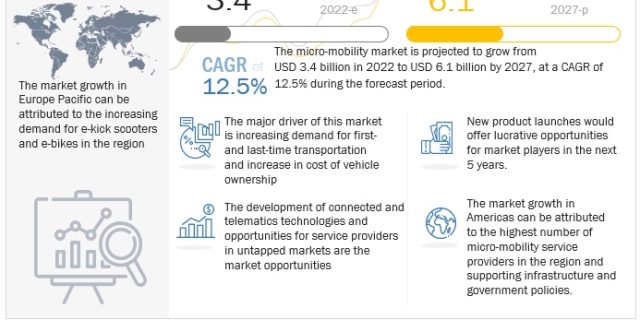
The micro-mobility market is predicted to experience substantial growth, with an estimated increase in value from USD 3.4 billion in 2022 to USD 6.1 billion by 2027, at a CAGR of 12.5% during the forecast period.
Various factors contribute to the growth opportunities in the micro-mobility industry, including the development of connected and telematics technologies, the potential for service providers in untapped markets, and the entry of electric two-wheeler and component manufacturers into the micro-mobility business.
Currently, the human-powered micro-mobility segment holds the largest market share. This can be attributed to the challenges users face with electrically powered micro-mobility vehicles, such as limited battery capacities and a lack of charging infrastructure.
Request Sample Report: https://www.marketsandmarkets.com/requestsampleNew.asp?id=71389422
The Americas lead in the human-powered (pedal-assist) micro-mobility segment. North America, in particular, witnesses a high demand for pedal-assist bicycles compared to e-bikes. Factors such as health benefits, cost-effectiveness, and easy availability contribute to the increasing demand for pedal-assist bicycles in the region.
The Asia Pacific region is expected to be the largest micro-mobility market during the forecast period. Factors driving this growth include a rising population, improving 4G/5G infrastructure and smartphone penetration, affordable micro-mobility services compared to other ride-sharing options, and increased venture capital and strategic investments. Countries like China, Singapore, Japan, and India have invested in smart transportation infrastructure, positioning them strongly in the Asia-Pacific market. Planned investments to improve urban transport and traffic infrastructure further contribute to the growth of the micro-mobility market in the region.
While the Asia Pacific offers promising growth opportunities for micro-mobility, the lack of regulations can result in an oversaturated market with bicycles piling up in city streets. Efforts are being made to develop micro-mobility infrastructure and partnerships with municipal transport authorities to address these challenges.
The increasing number of mega cities and population growth in developed and developing countries have highlighted the importance of deploying a smart transportation network. Micro-mobility services in Asia Pacific are seen as a solution to address issues such as traffic congestion, air pollution, and greenhouse gas emissions.
In South Korea, the growth of electric vehicles is driven by infrastructure development for micro-mobility vehicles, such as bicycle lanes and docked bicycle stations near public transport stations and tourist areas. Startups like SWING are expanding their e-vehicle operations and exploring last-mile delivery services through e-scooters and e-mopeds.
Inquire Before Buying: https://www.marketsandmarkets.com/Enquiry_Before_BuyingNew.asp?id=71389422
China, being the largest market for the mobility business, has embraced micro-mobility as a means to reduce carbon emissions and alleviate traffic issues. The availability of charging stations and the government’s incentives for emission-free vehicles and micro-mobility sharing services have contributed to the market’s growth.
The Asia Pacific region is home to major micro-mobility players, including Niu International, Yulu, Beam Mobility Holdings, E-Stralian, Hello-Bike, Lyft, Moovit, and Lime.
The micro-mobility market is primarily dominated by globally established companies such as Bird Global, Lyft, Lime, Helbiz, Dott, TIER, Bolt, Voi, and Veo. These companies have a strong presence and contribute to the growth of the market.
Related Reports:
Ride Sharing Market – Global Forecast to 2026
Mobility as a Service Market – Global Forecast to 2030
Robotaxi Market – Global Forecast to 2030


